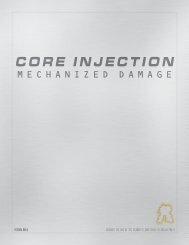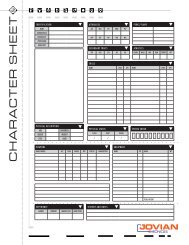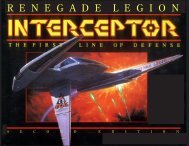renegadelegionneveren dingoffensive - Catsden.net
renegadelegionneveren dingoffensive - Catsden.net
renegadelegionneveren dingoffensive - Catsden.net
Create successful ePaper yourself
Turn your PDF publications into a flip-book with our unique Google optimized e-Paper software.
RVLS<br />
Movement Rules<br />
Ground vehicles are not created equally. Each<br />
differing movement system offers advantages, and<br />
disadvantages. Grav vehicles, wheeled, tracked--they<br />
all perform differently. Each movement type has their<br />
own terrain costs (noted on the Terrain Table) as well<br />
as some special construction rules:<br />
Wheeled vehicles: Wheeled Vehicles range from 4<br />
to 8 wheels, and combat vehicles are always made<br />
for off road combat. Add +2 Movement Points to<br />
wheeled vehicles (above their resulting base). They<br />
are, however, the most limited in the terrain they can<br />
travel. If a wheeled vehicle spends a full turn travelling<br />
along a prepared road, they gain 150% (gravel road)<br />
to 200% (paved road) their regular movement.<br />
Tracked vehicles: Tracked vehicles usually have<br />
2 tracks, but sometimes 4, and are optimised for<br />
off road combat. They only gain a bonus of 150%<br />
movement when on a well prepared road--this,<br />
however, seriously increases the wear on the tracks.<br />
Hover vehicles: The step just before Grav movement,<br />
hover vehicles behave essentially like grav vehicles,<br />
though they have far less power behind them. Hover<br />
vehicles must install lifting engines, which cost<br />
1/2 the weight of a grav drive. They gain 200%<br />
movement on ANY road (so long as they spend their<br />
full turn travelling on it)<br />
Grav vehicles: Lastly we have Grav vehicles, which<br />
we all know well. Like hover vehicles, they gain<br />
200% on any road. Level changes are handled a bit<br />
differently as well. A Grav tank may occupy whatever<br />
level it wishes, riding high above the terrain by<br />
simply paying the cost of a level change as listed on<br />
the terrain table. To change to LAF, two thrust points<br />
must be spent, as well as a hex of forward movement,<br />
putting the tank quite high up (and allowing high<br />
velocities).<br />
Travelling through terrain for all movement types<br />
has also changed. Listed on the terrain table is the<br />
extra cost of negotiating the terrain. For conventional<br />
vehicles, the listed cost is in MPs. An NA means the<br />
terrain is not traversable by that movement system. Of<br />
course, the base cost to enter a hex, is one MP/VP.<br />
Grav vehicles, by the nature of their movement<br />
mechanics, opperate differently. A Grav vehicle’s VPs<br />
are it’s ‘maneuver envelope’, which allows it to travel<br />
over distance. When it must negotiate terrain, either<br />
woods, or rough ground, it weaves a bit left and right,<br />
slowing down here and there, and expending thrust<br />
to pop up, twist left, and the like. Thus, the value<br />
listed on the terrain table is the extra VPs expended<br />
to traverse the terrain, but these VPs are burned off.<br />
Subtract these VPs from the final velocity of the tank<br />
at the end of the turn (effectively, ‘slowing’ down<br />
the tank). Of course, thrust can be used to keep the<br />
velocity the same.<br />
Alternately, since thrust and VPs are quite<br />
interchangeable in many ways, instead of the value<br />
on the table burning VPs, it is instead the thrust cost<br />
needed to traverse the terrain. There is no velocity<br />
adjustment. Semantics, perhaps, but to some it may<br />
makes more sense, and be easier to administer.<br />
There are no changes to the maximum velocity rules.<br />
Terrain Table<br />
The new, expanded, terrain table is found on the<br />
following page.<br />
XXII





